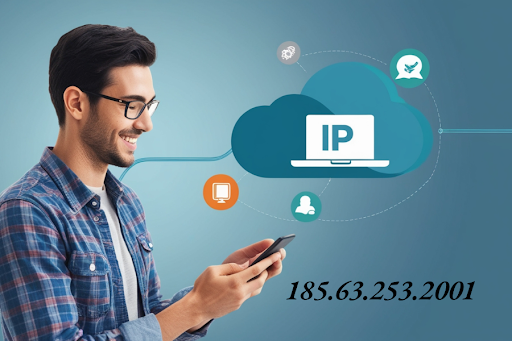Everything You Need to Know About 185.63.253.2001: A Beginner-Friendly Guide
In today’s digital-first world, everything that connects to the internet from websites and apps to online games relies on something called an IP address. You might have seen a string like 185.63.253.2001 and wondered what it is, whether it’s safe, and if you can or should interact with it.
In this comprehensive guide, we’ll walk you through everything you need to know about this mysterious-looking number. We’ll explain what it means, how it works, and what to do if you come across it in your logs, emails, or web activity. No complex tech jargon, just clear, simple explanations.
What is an IP Address?
An IP address, short for Internet Protocol address, is the online version of a home address. It identifies a device on a network and helps information get to where it needs to go. Just like the postal system relies on street addresses to deliver mail, the internet uses IP addresses to send and receive data between devices.
There are two primary types of IP addresses in use today:
- IPv4 (Internet Protocol version 4): This is the most widely used format, consisting of four sets of numbers separated by dots. A typical IPv4 address looks like 192.168.1.1 or 185.63.253.200.
- IPv6 (Internet Protocol version 6): This is the newer version designed to support more devices due to the internet’s rapid growth. It looks longer and more complex, for example: 2001:0db8:85a3:0000:0000:8a2e:0370:7334.
Wait.. What About 185.63.253.2001?
At first glance, 185.63.253.2001 might appear to be an IPv4 address but it’s not valid in standard IPv4 format. A legitimate IPv4 address must contain only four numbers, each ranging from 0 to 255.
So, what’s the deal with 185.63.253.2001?
This is likely a misformatted IP address, possibly a typo. It’s possible the author intended to write:
- 185.63.253.200 → a valid IPv4 address
- 185.63.253.2001 → a valid IP address with port 1 specified
It’s easy to get confused because IP addresses and ports are often used together, like this: IP:Port.
What is a Port?
Imagine your computer as a big office building. The IP address is the building’s street address, while ports are the individual office rooms inside that building. Each port allows your computer to communicate with different services, like websites, games, or cloud storage.
There are 65,535 ports available, and each is typically assigned to a particular service or protocol. Some common ports include:
- 80 – Used for standard web traffic (HTTP)
- 443 – Used for secure web traffic (HTTPS)
- 21 – For FTP (File Transfer Protocol)
- 22 – For SSH (Secure Shell access)
- 3306 – For MySQL databases
So when you see something like 185.63.253.2001, it means the IP address 185.63.253.200 is communicating over port 1.
Understanding Port 1: Is It Common?
Port 1 is among the least commonly used ports on the internet. While technically functional, it’s usually not assigned to any major applications or web services. It’s considered a “low-numbered” port, which is often more closely monitored for security reasons.
Possible Uses for Port 1:
- Testing or experimental setups: Developers may use obscure ports like port 1 to avoid conflicts.
- Custom internal services: In private networks or specialized environments.
- Misconfigured systems: Sometimes systems unintentionally leave port 1 open.
- Security scanning: Hackers might test uncommon ports like port 1 to identify weaknesses.
Is 185.63.253.200:1 a Security Threat?
Possibly. While 185.63.253.2001 could simply be a placeholder or test address, there are reasons to be cautious:
- Port 1 is not used by legitimate public services.
- Unusual ports are common targets in cyberattacks.
- Malware or backdoors may operate through low-numbered ports.
- Hackers often scan ports like :1 to look for open doors.
If you’re a server admin or running your own website, seeing connections to port 1 should prompt further investigation.
Can You Access 185.63.253.2001 in Your Browser?
In general, no most web browsers like Chrome, Firefox, or Safari don’t support direct access to such low-numbered ports unless a very specific service is running there.
If You Try to Visit:
cpp
CopyEdit
http://185.63.253.2001
Here’s what could happen:
- The page shows an error: No service is running at that address.
- It times out: Port 1 may be closed or blocked by a firewall.
- It connects: Unlikely, but possible if a custom service is listening.
Browsers expect web servers to respond on port 80 (HTTP) or 443 (HTTPS). Port 1 doesn’t normally serve web pages.
How to Check If 185.63.253.2001 is Active
There are a few ways to determine if an IP address and port are active:
Online Tools:
- yougetsignal.com
- portchecker.io
- ping.eu
These tools let you enter the IP address and port number and see if it’s accessible or open.
Command Line Tools:
If you’re comfortable using the terminal or command prompt, you can use the Telnet command:
bash
CopyEdit
telnet 185.63.253.2001
If you get a response, the port is open. If not, it’s likely closed or blocked.
What If 185.63.253.2001 Appears in Your Server Logs?
If you’re running a website, mail server, or any internet-facing service, you might encounter IP addresses like 185.63.253.2001 (or a corrected version like 185.63.253.200) in your logs or email headers.
Here’s What You Can Do:
- Run a WHOIS Lookup:
Use websites like whois.domaintools.com or arin.net.
These tools reveal who owns the IP, which data center it’s from, and which ISP is responsible. - Check for Abuse:
Use AbuseIPDB.com to see if the IP has a reputation for spam, DDoS attacks, or hacking. - Scan for Threats:
Enter the IP into VirusTotal.com to scan it against multiple security databases. - Block Suspicious IPs:
If the IP seems malicious, block it using your firewall, router, or web server configuration.
Why Would Someone Use 185.63.253.2001 or Port 1?
Although rare, there are several reasons someone might use this configuration:
- Custom Software Testing: Developers use uncommon ports to avoid conflicts with default services.
- Private Server Networks: Some internal systems use obscure IP/port combos for security through obscurity.
- Malware or Exploits: Cybercriminals often target low-numbered ports that may be left open by mistake.
- Educational or Research Projects: Students or researchers may simulate attacks or server setups.
More often than not, if you encounter 185.63.253.2001, it’s a typo or an attempt to obfuscate a real address.
How to Stay Safe from Suspicious IPs and Ports
Even if you’re not a network engineer or system admin, you can take proactive steps to stay protected:
Security Best Practices:
- Don’t open unnecessary ports on your devices or router.
- Use a firewall to block unused or risky ports like port 1.
- Update your software and OS regularly to patch vulnerabilities.
- Use strong passwords for services like SSH, FTP, or RDP.
- Scan incoming traffic using antivirus and malware protection.
- Monitor server logs for suspicious or repeated connection attempts.
- Whitelist only the ports and IPs you trust.
Summary Table
| Feature | Details |
| IP Address | 185.63.253.2001 (likely misformatted) |
| Correct Form | 185.63.253.200:1 (IP + Port 1) |
| IP Version | IPv4 |
| Port Type | Low-numbered, rarely used |
| Use Cases | Testing, internal services, scanning, misconfigurations |
| Browser Access | Unlikely to work |
| Security Risk | High if left open |
| Tools to Check | WHOIS, AbuseIPDB, Port Scanners, Telnet |
| Recommended Action | Block unless intentionally used |
Conclusion
While 185.63.253.2001 might look like a standard IP address at first glance, it’s actually a misformatted or misunderstood representation most likely meant to indicate 185.63.253.200:1, an IP address communicating over port 1. Although not inherently dangerous, any activity involving low-numbered or unusual ports should be examined with caution, especially in server logs or during cybersecurity audits. By understanding how IP addresses and ports work, and using free tools to verify their legitimacy, you can better protect your systems and avoid potential threats. Always err on the side of caution when dealing with unknown IPs or ports that aren’t commonly used.
FAQs:
Q1. Is 185.63.253.2001 a valid IP address?
No, 185.63.253.2001 is not a valid IP in standard IPv4 format. It likely represents 185.63.253.200:1, which is an IP address with port 1 specified.
Q2. What does port 1 mean in networking?
Port 1 is a low-numbered network port that’s rarely used by public applications. It can be used for testing, internal tools, or may appear in scanning activity.
Q3. Can I access 185.63.253.2001 in my browser?
In most cases, no. Standard browsers look for websites on port 80 (HTTP) or 443 (HTTPS). Port 1 is not typically used for web browsing and may result in an error or timeout.
Q4. Is 185.63.253.2001 dangerous?
While it’s not inherently dangerous, unusual IP and port combinations like 185.63.253.200:1 could indicate misconfiguration or even malicious scanning attempts. It’s best to investigate further if you see it in your logs.
Q5. How can I check if 185.63.253.2001 is active?
Use tools like YouGetSignal, PortChecker, or command-line utilities like telnet to test if the IP and port are open and responsive.
Q6. What should I do if I find 185.63.253.2001 in my logs?
Run a WHOIS lookup, check the IP on AbuseIPDB and VirusTotal, and consider blocking it with a firewall if it appears suspicious or linked to malicious activity.
Stay in touch to get more news & updates on Forbes Take!






